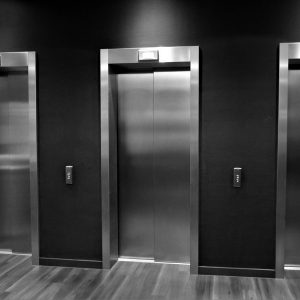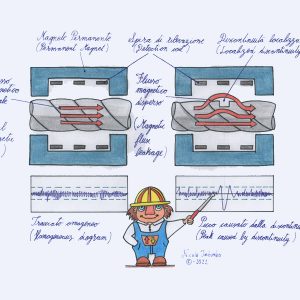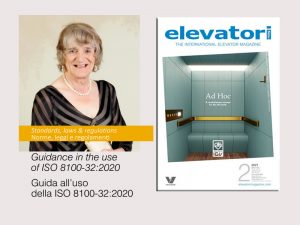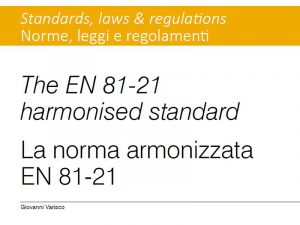Firefighter lifts and the operation in the event of a fire – Part 3
By Giovanni Varisco
Published on Elevatori Magazine Issue 3 Year 2019
We are continuing with this article to deal with two harmonised European standards which are of fundamental importance for lifts in buildings with fire risks.
These are EN 81-72 (Safety rules for the construction and installation of lifts – Particular applications for passenger and goods passenger lifts – Firefighters lifts) and EN 81-73 (Safety rules for the construction and installation of lifts – Particular applications for passenger and goods passenger lifts – Behaviour of lifts in the event of fire).
It is immediately clear that these are harmonised standards to be applied not for all lifts but for those lifting installations which have to comply with important fire-fighting requirements which also have to take into account the different national legislations which are, however, different from Member State to Member State of the European Union.
Here below we report the description of the main requirements established by the standards.
Lift machine and associated equipment
Any compartment containing the lift machine and its associated equipment shall be provided with at least the same degree of fire protection as is given to the lift well. Wherever any machinery space is located outside of the well and outside of a fire compartment, it shall be protected with at least the same fire resistance as the fire compartment.
Control Systems
A firefighters lift switch shall be located in the lobby intended to be used as the firefighters service access level. Operation of the firefighters lift switch shall be by means of the emergency unlocking key: the firefighting operation shall be indicated as this service has two phases.
On operation of the firefighters lift switch, all lift safety devices shall remain operative apart from the door reversal devices. The firefighters lift switch shall not override the inspection control or the emergency electrical operation.
Phase 1: Priority recall for the firefighters lift
This phase can be manually or automatically initiated and it causes:
• the lighting of the well and machinery spaces,
• Controls are rendered inoperative and all existing registered car and landing calls are cancelled,
• The firefighters lift must function independently from all other lifts,
• Audible and visible signals of warning.
The lift operation occurs as follows:
• The firefighters lift travels to the firefighters service access (non-stop movement),
• A lift moves from the access level and carries out a standard stop, then reverse the travel and reaches the access level,
• A lift travelling towards the access level shall move in a non-stop mode,
• On arriving at the fire service access level the firefighters lift shall be retained there with the car and landing doors kept in the open position.
Phase 2: Use of the lift under firefighters control
In this phase the control is entirely allocated to firefighters and the passage from Phase 1 to 2 can occur only by means of the firefighters lift switch.
The Phase has the following operational features:
• it shall not be possible to register more than one car call simultaneously,
• closing of the door with constant pressure (dead man operation) of car pushbutton or door open button,
• re-opening of the door if the button is released,
• if the car is stationary at a landing, it shall be possible to control the opening of the doors only by the application of constant pressure on the `door open’ car button. If the `door open’ car button is released, the doors shall automatically re-close.
Double access car
There are requirements to allow the secure opening of the door (one of the two existing) for the activity carried out by Firefighters, taking into account any double car pushbutton panel.
Power supplies for firefighters lifts
The power supply system of the lift shall be double and the secondary power supply shall be sufficient to run the firefighters lift at the rated load and speed for a period equal to the structure resistance.
Protection for car and landing controls
The standard states the requirements of fire resistance and resistance to moisture in order to maintain operational the firefighters lift also in difficult conditions such as in a fire event.
Communication system
A firefighters lift shall have an intercom system between the car and access level, machinery spaces, control centre and landings.
Vandal prone areas
Where a firefighters lift is installed in a vandal prone area, the protection requirements of EN 81-71 shall also apply at the same time of the firefighting operation.
During this operation, any alarm filter shall be suspended up to the standard operation is put back to normal.
Conformity verification
A special chapter of EN 81-72 standard reports in detail the verifications to be carried out at the end of the assembly procedure of the firefighters lift and before commissioning.
For each control, the methods are stated for tests and verifications:
• visual inspection,
• functional test,
• measurement,
• design document check,
• User and maintenance instructions check.
User and maintenance instructions
One chapter of the harmonised standard states with relevant details the information for the installer to be added to the information required for a “standard” lift.
This is obviously referred to the firefighters lift which will have a bigger manual with more contents.
A huge importance has been given to instructions for the various phases (Phase 1 and Phase 2, previously mentioned) as well as the accomplishment of various rescue operations required in the case of fire.
Annexes
The EN 81-72 standard is completed by various Annexes focusing on important topics and details, such as:
• Firefighting concept in the buildings,
• The basic layout of a firefighters lift,
• Power supply,
• Water protection,
• Water management,
• Concepts of fire compartments,
• Pictogram for a firefighters lift,
• Examples of rescue concept for firefighters,
• Building interface,
• Maintenance requirements.
In the next issue of the magazine we will analyse additional EN 81 standards in depth, thus promoting our activity of spreading the knowledge and contents of safety standards relevant to lifts.





